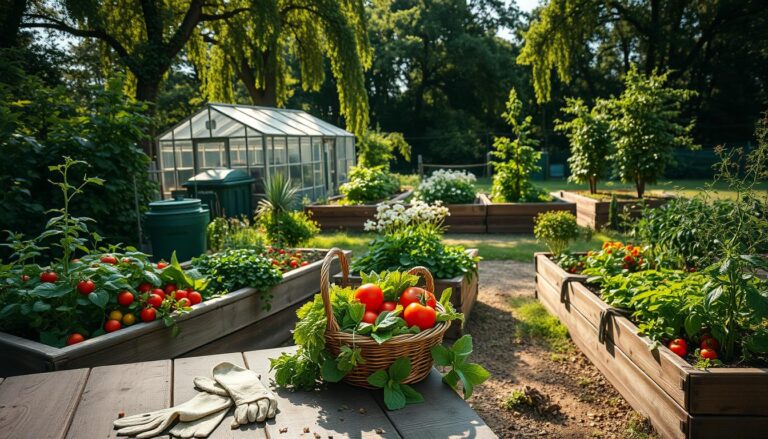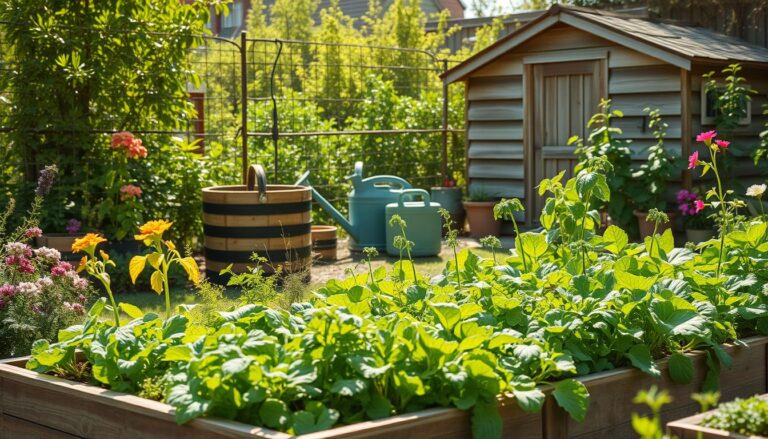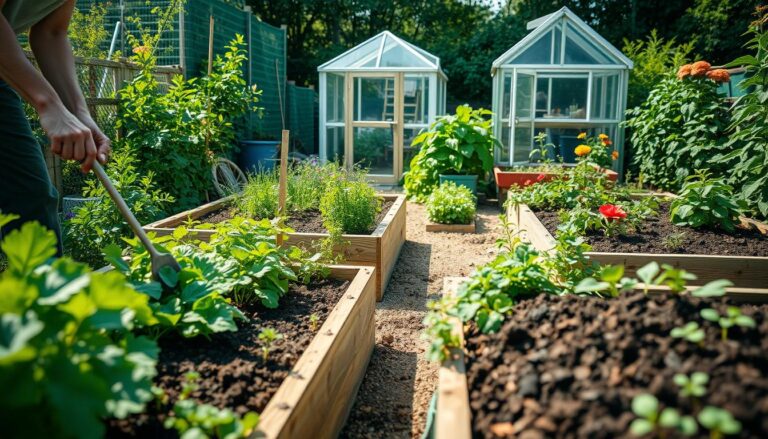Starting your organic gardening journey can be very rewarding. It lets you grow your own food and connect more with nature.
First, you need to learn the basics and pick the right tools and materials. By using sustainable gardening practices, you’ll grow your own food and help the environment.
This guide is here to help you start your organic garden. It’s easy to follow and will teach you the basics. You’ll learn about natural gardening and how to make your garden the best it can be.
What is Organic Gardening?
Organic gardening is a way to grow plants that’s good for the planet. It helps make food healthier and keeps our environment clean. This method avoids harmful chemicals and genetically modified organisms (GMOs).
Understanding the Basics
To start organic gardening, you need to know the basics. Soil health is key. It’s the base of gardening. Organic gardening uses natural stuff to keep soil rich and control pests.
Composting is a big part of it. It turns waste into something good for the soil. Using natural ways to fight pests keeps the garden balanced.
Benefits of Organic Gardening
Organic gardening has many good points. It’s good for you and the planet. Here are some main benefits:
| Benefit | Description |
|---|---|
| Improved Soil Quality | Organic gardening makes soil better for plants to grow. |
| Healthier Plants | Without harmful chemicals, plants are cleaner and safer to eat. |
| Environmental Sustainability | It’s better for the environment, saving nature and keeping things balanced. |
Choosing organic gardening helps make the world a better place. You get fresh food and connect more with nature.
Getting Started with Organic Gardening
Starting your organic garden journey is exciting. First, you need to know how much space you have and where to put your garden. This is the first step to a successful garden.
Assessing Your Space
Before planting, look at the space you have. Think about your yard’s size, layout, and any features like trees or slopes. Measure your garden area to see how much space you have for plants.
It’s also important to make sure your garden is easy to get to. This makes it simpler to do tasks like watering and weeding.
| Space Characteristics | Ideal Conditions | Considerations |
|---|---|---|
| Sunlight Exposure | 6+ hours direct sunlight | Most vegetables and flowers need lots of sunlight. |
| Soil Quality | Well-draining, rich in organic matter | Test your soil to see its type and nutrient level. |
| Accessibility | Easy to reach for maintenance | Think about pathways and how close it is to water. |
Choosing the Right Location
After checking your space, pick the best spot for your garden. Consider the microclimates in your yard. Different spots may have different sunlight, wind, and frost.
For beginners, start small. This helps you learn and grow your garden as you get better at organic gardening.
By carefully looking at your space and picking the right spot, you’re ready for a great organic gardening experience. Remember, a good garden isn’t just about the plants. It’s also about creating a place that helps them grow well.
Selecting the Best Organic Seeds
The journey to a thriving organic garden starts with picking the best organic seeds. This step is key to a successful harvest. It’s important to know the different types of seeds out there.
Choosing the right seed type is crucial for your garden’s health and productivity. Organic seeds are bred to be tough and adaptable. They’re perfect for sustainable gardening.
Heirloom vs. Hybrid Seeds
Organic gardeners often choose between heirloom and hybrid seeds. Heirloom seeds are pollinated naturally by bees, butterflies, or wind. They have rich genetic diversity and are loved for their unique flavors and traits.
Hybrid seeds are bred for specific traits like disease resistance or higher yields. While they have benefits, they might not be the best for organic gardeners. This is because they often can’t be saved for future planting.
| Seed Type | Characteristics | Benefits |
|---|---|---|
| Heirloom | Open-pollinated, rich genetic diversity | Unique flavors, adaptable to local conditions |
| Hybrid | Bred for specific traits, higher yields | Disease resistance, improved shelf life |
Where to Buy Organic Seeds
After choosing your seed type, find a reliable place to buy them. You can check local nurseries, online seed retailers, or seed libraries.
When buying organic seeds, look for sellers who are open about their seeds’ origin and quality. Check for “USDA Organic” certifications to ensure the seeds meet organic standards.
By following a step-by-step guide to picking organic seeds, your garden will have a strong start. Whether you’re experienced or new to gardening, choosing the right seeds is key to a successful harvest.
Soil Preparation and Health
The success of an organic garden starts with the soil. Preparing and keeping the soil healthy is key. It’s a basic step for organic gardening basics for novices.
Before planting, you need to know your soil’s condition. This means testing your soil to check its pH level and nutrient content.
Testing Your Soil
Testing your soil is easy with a DIY kit or by sending a sample to a lab. It shows your soil’s pH level. Most plants like a slightly acidic to neutral soil pH (6.0 to 7.0).
Improving Soil Quality
After getting your soil test results, you can start improving it. You might need to adjust the pH or add nutrients. Improving soil quality takes time and regular checks.
Adding organic matter like compost or manure helps a lot. These improve soil structure and give plants the nutrients they need.
Organic Soil Amendments
There are many organic soil amendments to choose from. Compost is full of nutrients and good microbes. Manure adds a lot of nitrogen, phosphorus, and potassium.
- Compost: Rich in nutrients and improves soil structure.
- Manure: High in nitrogen, phosphorus, and potassium.
- Green manure: Crops like clover or rye that are grown and then incorporated into the soil to add nutrients.
By using these organic gardening basics for novices, like natural amendments and less tillage, you can make your garden thrive.
Essential Organic Gardening Tools
The right tools are key to a thriving organic garden. Starting your organic gardening journey? It’s crucial to get the right equipment for a healthy garden.
Hand Tools for Beginners
For new gardeners, basic hand tools are a must. A trowel is needed for digging and moving plants. A rake helps level the soil and clear debris. A watering can or a soft hose with a spray nozzle is vital for watering without harm.
Beginners should also have a pruning shears for trimming and a gardening glove to protect hands from thorns and dirt. These tools will make gardening easier and more fun at the start.
Tools for Larger Gardens
As your garden expands, you’ll need more specialized tools. A hoe is great for weeding and preparing the soil. A cultivator loosens the soil and improves drainage. For bigger gardens, a wheelbarrow or garden cart is handy for moving plants, soil, and supplies.
Gardening expert,
“The right tools make gardening more efficient and enjoyable. Investing in quality tools may seem expensive at first, but it’s worth it in the long run.”
Choosing the right tools will make your organic gardening journey more rewarding and successful.
Planting Your First Organic Garden
Starting your first organic garden is a thrilling step towards a greener life. As a beginner, knowing the basics is key to a bountiful harvest. A beginner’s guide to organic gardening will help you grow a garden that’s not just fruitful but also eco-friendly.
Understanding Planting Seasons
Each crop has its best planting time, depending on the season. Knowing these planting seasons is vital for a good harvest. Spring and fall are usually the best times in most areas, with better weather.
Cool-season crops like broccoli and kale love the cooler spring or fall air. On the other hand, warm-season crops such as tomatoes and peppers prefer the summer heat.
Companion Planting Basics
Companion planting pairs plants for better growth, pest control, or taste. This method boosts your garden’s health and output. For example, marigolds with tomatoes can keep nematodes away, and basil can make nearby veggies taste better.
Using these techniques, you can build a balanced garden. It will be stronger against pests and diseases.
Natural Pest Control Methods
Keeping your garden healthy means using natural pest control. Organic gardening is more than avoiding chemicals. It’s about making a space where plants and helpful bugs live well together.
Introducing Beneficial Insects
Bringing in helpful bugs is a top way to fight pests naturally. Ladybugs and lacewings eat aphids and other pests, cutting down on the need for harmful sprays. Bees and other pollinators are also key to a healthy garden.
To draw these helpful bugs, plant a variety of flowers and herbs. Marigolds and dill, for instance, attract them.
Organic Pest Management Techniques
There are many ways to manage pests organically. You can use physical barriers, rotate crops, and apply natural pesticides.
- Physical barriers, like row covers, keep insects away from plants.
- Crop rotation stops pests’ life cycles, lowering their numbers.
- Organic pesticides, like neem oil and diatomaceous earth, control pests without harming good bugs.
Here’s a look at some common organic pest control methods:
| Technique | Description | Effectiveness |
|---|---|---|
| Physical Barriers | Prevents pests from reaching plants | High |
| Crop Rotation | Breaks pest life cycles | Medium |
| Organic Pesticides | Controls pest populations | High |
By using these organic gardening tips for beginners, you can keep pests away while keeping your garden healthy. The secret to organic gardening is a balanced space for plants and beneficial bugs.
Watering Techniques for Organic Gardens
Watering is key to a healthy organic garden. It affects how well plants grow and thrive. Knowing how to water right is important. This means knowing how often and how to do it, to save water and help plants grow.
Importance of Proper Watering
Watering correctly is vital for many reasons. It makes sure plants get the right amount of moisture. Too much water can harm plants, while too little can stress them out. Good watering keeps plants healthy and helps them grow strong.
Also, it helps save water. Organic gardening is all about being green. Using methods like drip irrigation and mulching saves water and makes soil better.
Best Practices for Irrigation
Choosing the right way to water is crucial for your garden’s success. Here are some top tips:
- Use drip irrigation or soaker hoses to water roots directly, cutting down on evaporation and runoff.
- Mulch around plants to keep soil moist and stop weeds.
- Water when it’s cooler to avoid losing water to evaporation.
- Check soil moisture by hand or with a moisture meter.
Let’s look at how different watering methods compare:
| Watering Method | Water Efficiency | Impact on Soil Health |
|---|---|---|
| Drip Irrigation | High | Positive, as it reduces soil disturbance |
| Soaker Hoses | High | Positive, similar to drip irrigation |
| Sprinkler Systems | Moderate | Can be negative due to potential for overwatering and soil compaction |
By following these tips and understanding the importance of watering, you can make your organic garden healthier and more productive. Remember, efficient watering is key when starting your organic gardening journey.
Maintaining Your Organic Garden
To keep your organic garden thriving, regular maintenance is key. This includes tasks that keep your garden healthy and productive all season. By using beginner-friendly organic gardening methods, you can enjoy a big harvest and help the environment.
Good garden care is not just fixing problems. It’s also about stopping them before they start. Regular care lets you spot issues like pests or nutrient gaps early. This way, you can fix them before they get worse.
Weeding and Mulching
Weeding is crucial for your organic garden. Weeds take water, nutrients, and light from your plants, hurting their growth. Weeding regularly helps your plants grow better.
Mulching is also very important. It keeps the soil moist, stops weeds, and controls soil temperature. You can use organic mulches like straw, bark chips, or grass clippings easily.
| Mulch Type | Benefits | Application Tips |
|---|---|---|
| Straw | Retains moisture, suppresses weeds | Apply 2-3 inches thick around plants |
| Bark Chips | Long-lasting, aesthetically pleasing | Use 3-4 inches thick, keeping it away from plant stems |
| Grass Clippings | Rich in nutrients, easy to apply | Apply thin layers to avoid matting, allowing air circulation |
“Mulching is a simple yet effective way to improve soil health and reduce garden maintenance. It’s a practice that every organic gardener should adopt.”
Fertilizing Organically
Fertilizing is key to keeping your soil fertile and plants healthy. Organic fertilizers give nutrients slowly, avoiding the over-fertilization problems of synthetic ones.
Some great organic gardening techniques for beginners include compost tea, fish emulsion, and manure tea. These natural options are full of nutrients and microbes that make your soil better.
- Compost Tea: Rich in beneficial microbes, promotes soil health
- Fish Emulsion: High in nitrogen, phosphorus, and other micronutrients
- Manure Tea: Provides a broad spectrum of nutrients, improves soil fertility
By doing these tasks regularly, you can keep your organic garden healthy and productive. Weeding, mulching, and organic fertilizing are essential for a big harvest. They follow beginner-friendly organic gardening principles well.
Harvesting and Enjoying Your Produce
After months of planning and care, your organic garden is ready to give you a big harvest. As a beginner, seeing your hard work pay off is incredibly rewarding. Harvesting your produce is the best part of the journey.
Crop Maturity Indicators
Knowing when to pick your crops is key to enjoying their best taste and texture. Check your seed packets or look up the specific signs for each type. For example, tomatoes are ready when they’re fully colored and a bit soft. Leafy greens are ready when they’re the size you want.
Proper Storage Techniques
To enjoy your harvest for longer, proper storage is crucial. Use containers or bags that let air in to keep your produce fresh. For longer storage, freeze or can your produce. These simple tips help you enjoy your garden’s bounty all year, making your gardening journey even more rewarding.
FAQ
What is the first step in starting an organic garden?
How do I improve the soil quality in my organic garden?
What are the benefits of using heirloom seeds in organic gardening?
How can I control pests in my organic garden without using synthetic chemicals?
What are some effective watering techniques for organic gardens?
How often should I fertilize my organic garden?
What are some beginner-friendly organic gardening practices?
How do I store my harvested produce to keep it fresh for longer?

Sortemdia nasceu com o propósito de trazer alegria e oportunidades para todos por meio de sorteios gratuitos de prêmios incríveis. O site tem como missão oferecer experiências acessíveis, divertidas e justas para quem deseja concorrer a produtos, serviços e brindes sem pagar nada por isso. Acreditamos que a sorte pode bater à porta de qualquer pessoa — e no Sortemdia, ela pode chegar com apenas um clique.



